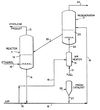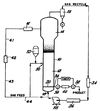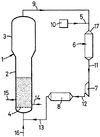Fluidized Bed Reactor/Research Development
FBR for ethanol to polyethylene two-step conversion
Questions for prototype
What material should the reactor be made of? How should the reactor manufactured? What equipment is required?
Literature and patent review
Production of Polyethylene Using Gas Fluidized Bed Reactor written by Tham Chee Mun reviews the industrial processes that have been employed and are currently used. The history of industrial polyethylene processes including reactor design and catalyst evolution, differences in polyethylene fibers, mathematical modeling of the polymerization reaction, and recommendations for operation are covered. Early processes were for the production of low density polyethylene and required high pressures in the order of 3000 atm and elevated temperatures, and this process is still used in the production of polyethylene vinyl acetate. Newer catalysts can produce higher density fibers at lower temperature and pressure and should be simplified and bootstrapped for OSE. Further refinements to the technique included starting the reactor with prepolymers, reconfiguration of the gas recycle line to conserve heat and reduce fouling, and pretreatment of the substrate and catalyst. Modeling of the reaction process incorporates the total possible reactions and their probability. A recommendation that OSE should consider while developing lines of plastics is the loss of transition material and a production process that cycles through similar plastics to minimize wasted material.
FBRs for ethanol dehydration
A reactor device detailed in U.S. patent 4,134,926 belonging to Tsao and Zasloff issued Jan 6 1979 utilizes a fluid bed reactor (11) to catalyzed the reaction of ethanol dehydration.
The reactor contains powdered catalyst supported on a distributor which can dispense feed ethanol through the catalyst. Ethanol is passed through the distributor in gas phase at 750 C into the reactor chamber at the same temperature. The catalyzed reaction takes place on the surface of the catalyst powder, and the product escapes as gas. The product is equal parts water and ethylene. Catalyst may be removed and loaded into reactor using hopper chambers, which offer the advantage of preparing the new catalyst to ideal temperature and conditions increasing control of the main reactors conditions. According to the patent ethylene yields of 99% are possible with fluidized bed reactors.
A thesis prepared by Michael James Skinner Ethanol Dehydration to Ethylene in a Stratified Autothermal Millisecond Reactor details the use of stratified reactors for ethanol dehydration. Stratified reactors have multiple catalyst beds that allow catalyzed reactions to take place in a rapid series, which previously had to be carried out by a combined cocatalyst or a support material. Chapter 1 deals with pairing of catalysts for the conversion of fast pyrolysis products to liquid hydrocarbons and should be reviewed in the context of that project. Chapter 2 covers novel research with a two layered stratified reactor and ethanol dehydration to ethylene under isothermal and adiabatic conditions. A noble metal and aluminum oxide is in the first layer reacts first followed by ZSM-5. The set-up achieved high conversion rates in the order of 90%+ however other simpler processes have shown better performance. Stratified reactors have the most practical use for biomass refining and takes intense process control.
FBRs for polymerization
Industry equipment often follows the dimensional guidelines of reactor bed height to width ratio of 6-7.5 and a reduction zone with a ratio 1:2 is connected to the top of the reactor with a sloping section that assists in separating catalyst and polymer from recycle gas. The reactor bed is usually kept at a pressure of 0.07 atm (1 psi). http://klmtechgroup.com/PDF/Articles/Fluidized-Bed-Reactor.pdf
US patent 4,003,712 issued to Miller on Jan. 18, 1977 details a fluid bed reactor for use in a olefin polymerization.
The reactor contains a reaction zone 12 where substrate and catalyst are combined. The substrate is supported by a fluid bed which allows the injection of substrate which allows maximum mixing due to the fluid like behavior of the catalyst. Unused substrate, catalyst, and carrier gas can be recycled through the system. Above the reaction zone is a slow down zone 14 where products collect and are sorted. Gas collects the velocity reduction zone and recycle gas is collected through the a line at the top of the zone. An optional cyclone 22 can aid in gas collection and a filter 24 catches small particles. A heat exchanger 26 acts to recycle heat and maintain the system at a constant temperature and the gas is compressed by a compressor 28. New catalyst can be added through input 30 with a proper gas mixture and preheated, reserve catalyst is held in nitrogen in 32.
US patent 4,383,095 issued to Goeke on May 10 1983 details a high activity catalyst and a the operation of the fluid bed reactor for its use. The FBR adds activator compounds at the hottest point of the gas recycle line which would be downstream of the compressor and before the heat exchanger?, however the patent calls for placement downstream of the heat exchanger.
US patent 5,028,670 issued to Chinhe and Dumain on July 1, 1991 details a fluid bed reactor configured for olefin polymerization so as to avoid fouling by particles carried into the gas recycle line.
A liquid vapor separation The device utilizes two heat exchangers in the gas recycle line downstream.
A thesis prepared by Michiel Friso Bergstra made kinetic measurements of ethylene and hexene polymerization in gas and slurry phase generators with multiple catalysts and details components of a laboratory grade/scale olefin polymerization reactor. The reactor chamber is a commercial 1600 ml stainless steel model with a jacket and other components are largely off the shelf. An an automated injection mechanism for dry catalyst uses a pressurized tube to add catalyst from the top of the reactor. Flow of gaseous ethylene, nitrogen, and hydrogen is controlled by thermal mass controllers and 1-hexene flow is controlled by thermal liquid mass flow. All components are mixed and brought to gas phase by a Controlled Evaporative Mixer (CEM, Bronckhorst HiTech) before passage to the reactor. A helical stirrer with a propeller tip maximizes circulation which is important for catalyst and reagent interaction and transfer of heat from the reaction to the cooling. Products are removed by a low pressure port through a mass thermal flow controller to gas analyzers. Infrared beam gas analyzers Servomax Xendos 2500 and 2500 are used to measure ethylene and 1-hexene concentration.
Analysis of Industry Standards
http://www.analis.be/files/VprodFiles/2236/radleysReactor_Ready_V2.pdf
http://www.parrinst.com/products/stirred-reactors/hp-ht-reactors-series-4570/
http://www.buchiglas.com/products/glass-reactors-pilot-plants/minipilot.html
http://www.alibaba.com/product-gs/554854550/8L_polymerization_reactor.html
http://www.aceglass.com/html/3dissues/Reactors/index.html
Polylactic Acid
Analysis of Industry Standards
http://www.alibaba.com/product-gs/557582322/Pilot_reactor_2L_Borosilicate_Condenser_Vacuum.html


